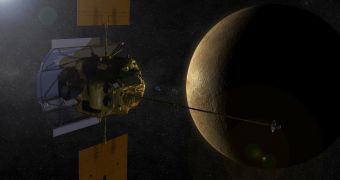In early April, the MESSENGER orbiter around Mercury will begin its science operations. Here is a view of the instruments the NASA Goddard Space Flight Center (GSFC), in Greenbelt, Maryland, developed for this first-of-a-kind mission.
The MErcury Surface, Space ENvironment, GEochemistry and Ranging (MESSENGER) probe is the first artificial satellite around Mercury. It achieved orbital insertion on Thursday night, March 17.
This is the first time NASA, or any other space agency for that matter, place a spacecraft in Mercurial orbit. Studies carried out with the instrument suite aboard the probe will undoubtedly help experts clear up some of the most intricate mysteries related to the innermost planet in our solar system.
Of the nine instruments aboard, the GSFC team leads or co-leads two, MAG (the vector fluxgate magnetometer) and MLA (Mercury Laser Altimeter). MAG was jointly developed with the Johns Hopkins University (JHU) Applied Physics Laboratory (APL) in Laurel, Maryland.
According to the science team at Goddard, MAG will be responsible for collecting magnetic field samples about 20 times per second. Over time, these readings will help planetary scientists determine the origins of the global magnetic field surrounding Mercury.
The instrument may also help experts get more insight into the nature of this field, while at the same time providing a better understanding of the magnetic properties the outer layers of the planetary crust displays.
“The dynamic interaction between the very strong flux of charged particle radiation from the Sun at 0.31 Astronomical Units (AUs) and Mercury's magnetic field is believed to be responsible for the huge day-to-day variations in this planet's atmosphere.” the GSFC team says.
“Mercury’s atmosphere is very tenuous and is believed to exist in part due to the sputtering of neutral atoms off the surface by solar wind ions that enter through "holes" in the shield created by this planet’s magnetic field,” the experts explains further.
The second instrument led by the GSFC crew is the MLA, whose main task will be to map the surface characteristics and landscape features of the Mercurial surface. The way it will go about doing this is shining an infrared laser on the surface, and calculating the time it needs for the light to return.
Differences in the amount of time various light beams take to return to MLA's detectors will then be translated into distances, and this will provide a map of altitudes at various locations on Mercury.
“These distance measurements are taken eight times per second, roughly 500 yards apart on the surface, yielding very accurate descriptions of the topography, or contours, of Mercury's landscape,” the Goddard team says.
In addition to MAG and MLA, the group will also be involved with the Radio Science (RS) instrument aboard MESSENGER. Its job is to determine how the planet's mass is distributed, by analyzing variations in the spacecraft's average distance from Earth.

 14 DAY TRIAL //
14 DAY TRIAL //